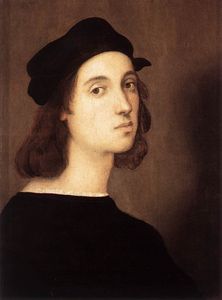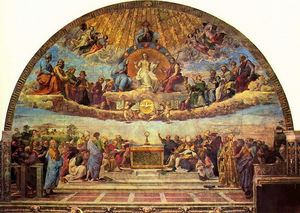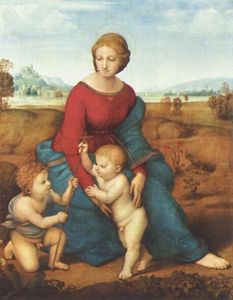Raphael Style and Technique
- Full Name:
- Raffaello Sanzio da Urbino
- Short Name:
- Raphael
- Alternative Names:
- Raphael, Raffaello Santi, Raffaello Sanzio
- Date of Birth:
- 06 Apr 1483
- Date of Death:
- 06 Apr 1520
- Focus:
- Paintings, Architecture, Drawings
- Mediums:
- Oil, Stone, Glass
- Subjects:
- Figure
- Art Movement:
- Renaissance
- Hometown:
- Urbino, Italy
- Raphael Style and Technique Page's Content
- Introduction
- Style
- Method
Introduction
Raphael was not an artistic innovator in the same sense as da Vinci and Michelangelo, yet has been praised as the ideal High Renaissance painter for the past five centuries. This is because in his art, Raphael portrayed noble and ideal individuals who move with dignity and grace through an intelligible and ordered world.
This was achieved by unifying the movements of his figures and the spaces he created for them into integrated, harmonious compositions. Raphael's order is not merely intellectual - the figures in his works seem to be impelled by an energy that causes them to twist and turn gracefully into his characteristic spherical compositions. So easy and beautiful is this motion that even at moments of drama they seem to project calm.
Raphael Style
Early years - the influence of Perugino:
It is nearly impossible to separate the style of Raphael in the early years from that of his master, Perugino. Indeed, Raphael's young hand must have played a part in many of Perugino's major commissions.
Raphael's debt to Perugino is evident when comparing Marriage of the Virgin to Perugino's Christ Handing the Keys to Saint Peter. One can note the same array of foreground figures, the same polygonal background temple and the same intervening piazza. Even the colors of the painting are derived from Perugino - the cloudless blue sky, the deep blues, roses and yellows and the blue green of the hills. Despite the similarities however, this work departs from Perugino in form and space. The graceful figures are woven into a unity unknown in Perugino's art.
Middle years - Florence:
Whilst in Florence, Raphael was influenced stylistically by several local artists he befriended there. Most notable was Fra Bartommeo, from whom Raphael learnt to replace the fragile grace of Perugino with a more measured movement, with more gravity and grandeur.
Raphael also adapted inventions in painting that connoisseurs would have immediately recognized as Leonardo da Vinci's. For example, Leonardo's compositional ideas lie behind Raphael's portrait of Maddalena Doni, and also the Florentine landscapes in which the figures are arranged into a pyramid or cone, with each part retaining a dynamic and organic relationship to the others.
Raphael's drawing style also changed in Florence, where more of his work was in pen and ink, often used as a rougher means of generating and exploring ideas as well as defining them. His sketches, perhaps made from memory, include works by Donatello, Michelangelo and Leonardo.
Later years - Rome:
In Rome Raphael's oil technique developed, perhaps because of his contact with Venetian painting, but also in response to his increasing familiarity with fresco painting. In Rome, Raphael also showed growing interest in color and light as pictorial elements independent of line and form.
The range of his impasto in some of his oil paintings has few parallels in the work of earlier artists, meaning this may have been one of his rare innovations. It is particularly evident in his paintings on canvas, and his increasing use of this support is one of the aspects of his work that suggests his knowledge of Venetian art.
More changes in style and technique can be observed in Raphael's drawings upon his arrival in Rome. There is the gradual abandonment of the metal point in favor of chalk, and his use of the new medium of red chalk especially for the studies for the female nudes in The Triumph of Galatea. Using a female nude model in itself was unusual (Raphael himself had previously employed boys as models for female figures).
Despite these changes, Raphael's methods as a painter were remarkably consistent. A compositional study for the early St Nicholas of Tolentino altarpiece shows his concern for underlying geometric structure in composition and his practice of studying each figure separately from a living model.
Raphael Method
Raphael's early artistic career coincided with the increase in use of oil paint in Italy, and most of his early works on panel seem to use oil. In many of his earliest offerings, egg tempera was used - a mixture common with artists of this period, including Perugino. By the time he settled in Rome however, all of Raphael's paintings were executed entirely in oil. Raphael painted on paper, and even perhaps vellum, and each of his tapestry cartoons consists of numerous sheets of paper glued together. The medium employed in these was a type of gouache in which the pigment was bound in animal glue.
Raphael seems to have experimented with the oil medium, perhaps in order to achieve the greater depth of shadow and richer colors associated with the oil medium, but another consideration may have been the fact that it would have been easier for him to revise his assistants' work in oil than it was in fresco.
Whilst working on large frescoes in Rome, Raphael employed assistants, and within a few years of settling there he had a workshop of talented pupils and associates. The exact nature of their contribution is often hard to discern, and it is unlikely that the division of labor was either consistent or systematic. Raphael seems to have intervened in preliminary, intermediary and final stages of a work and to have interested himself in both central and marginal parts.







